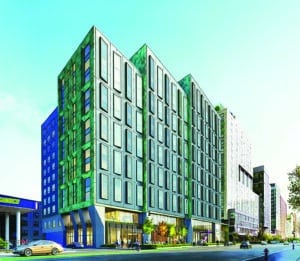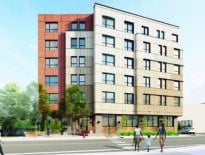
Construction of housing in a range of prices can help moderate increases throughout the marketplaces, according to research studies on the effects of multifamily development. Pictured is The Bon, developer Scape’s new 477-unit rental complex in the Fenway. Image courtesy of Gensler
Residents across Massachusetts continue to feel pain from our housing shortage. Recent population and construction trends demonstrate the underlying story: Massachusetts is not producing enough housing, and as demand outpaces supply, rents rise quickly.
From 2010 to 2021 Massachusetts experienced a population growth of approximately 440,000 people but only issued 180,000 housing construction permits to private sector builders. From 2009 to 2019, the Boston metro area produced 275,000 new jobs, but only 108,000 new homes.
As a result, a larger pool of buyers and renters are competing for a relatively smaller number of homes, driving up prices: Massachusetts is now ranked third in median housing prices, behind California and Hawaii.
The obvious answer is that Massachusetts must build more housing – increase supply to reduce competition. However, there is debate about how to accomplish this goal while also maximizing affordability. Many market-rate housing proposals are met with skepticism that the new construction will help affordability for the broader population; the claim is often made that new development only increases the stock of luxury housing, without making housing more affordable across the market.
However, recent studies challenge this notion, and support the idea that building market-rate housing can provide positive effects on the affordability of all types of housing. This is in part due to older market-rate housing “filtering down” to lower-income households; a 2017 report by the Hudson Institute showed that nearly a quarter of rental units for very-low-income renters for 2013 had previously been luxury apartments, with almost 20 percent having been luxury apartments in 2005.
A 2003 study showed the impact of reducing construction. In metropolitan areas where construction is harder, more units filter up, reducing the pool of apartments for the very-low income. Other studies show new luxury construction correlating with decreasing local rents. Thus, while targeting affordable housing is directly beneficial to affordability goals, local and state encouragement of various housing types will aid these goals, as well.
Barriers to a Straightforward Solution
Although this makes the answer to affordability seem straightforward – just build more housing! – Massachusetts faces challenges in accomplishing this due to the many barriers to construction.
Despite having the 15th largest state population, Massachusetts ranked 28th in housing permits issued in 2019. Although part of this may be due to higher labor and material costs, research shows that these variations do not account for all state-level construction differences. Stricter land-use regulations and more stringent or lengthy approval processes both make construction more expensive.
Expensive construction has impacts beyond lower housing supply and reduced affordability. Research shows additional housing constraints leads to worse rates of long-term employment for areas with increased demand for workers compared to metro areas with less restrictive regulations. Less housing near commercial centers results in workers having longer commute times, more automobile dependence and an overall increase in carbon emissions. Strict local land-use regulations, such as prohibitions on multifamily housing, correlate with higher rates of both income and racial segregation.

Josh Zakim
Facilitating new housing by reducing restrictions leads to a bevy of positive externalities throughout the community. The reduction of these artificial barriers not only allows more construction that will directly ease the housing shortage, but also contributes to the economic, environmental, and inclusionary health of our community.
To address the housing affordability crisis, Massachusetts needs to improve the construction process and reform existing regulations to encourage development of all housing types. While inclusionary zoning requirements and tax credits designed to produce immediately affordable homes are an important piece of the puzzle, reforming unnecessary land use regulations, increasing certainty in the permitting process and streamlining production are equally important.
Solving the housing affordability crisis requires state and local leaders to understand the costs of these regulatory barriers. By reducing these artificial obstacles, we can build a healthier Massachusetts; one with affordable homes, stronger local economies, and more inclusive communities.
Josh Zakim is executive director of Housing Forward MA.






